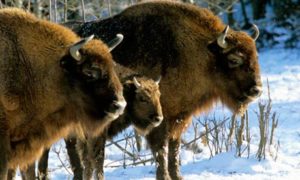Have you ever heard about the giant animals, the American Bison and the European Bison? These huge creatures have two different tales, but they are both fascinating. Let’s explore where they live, what’s happening with them today, and the fantastic efforts to keep them safe. In a world that’s changing fast, these bison are still symbols of wild beauty and the hard work of many people.

Meet the Mighty Bisons
Before we dive into their conservation, let’s get acquainted with the two bison species. First, let’s meet the American bison (Bison bison). These bison, often called American buffalo, naturally inhabit North America. They are the biggest land animals on this continent and are known for their humpbacked appearance. You can mostly spot them in the United States and Canada. Yellowstone National Park and the Grand Teton National Park are well-known spots for witnessing these impressive creatures in the United States. In Canada, bison populations thrive, particularly in Alberta and British Columbia.
At one point, it’s believed there were tens of millions of them, but due to excessive hunting, loss of their natural habitats, and diseases, their numbers dropped dramatically, almost pushing them to the brink of extinction in the late 19th century. Today, they are considered “Near Threatened,” according to the IUCN.
Now, let’s turn our attention to the European bison (Bison bonasus), also known as the wisent. These magnificent creatures inhabit the ancient woodlands and grasslands of Europe. You can find them in various European countries, including Poland, Belarus, Russia, Ukraine, and Lithuania, where they have established populations. One of the prime spots to catch a glimpse of these remarkable animals is the Białowieża Forest, stretching across the borders of Poland and Belarus.
While they share some similarities with the American bison, European bison have subtle differences in their physical traits. These resilient creatures were once on the edge of vanishing from the wild, but thanks to dedicated efforts, their numbers have rebounded, even though they are still considered “Near Threatened” by the IUCN.
Current Status and Population of Bison
According to the population estimates, the bison population is categorised at both the species and subspecies levels. At the species level, a total population of 31,000 individuals is distributed across 68 conservation herds. Among these, the number of mature individuals falls between 11,000 to 13,000.
The bison population at the subspecies level can be further broken down into Plains bison, accounting for 20,000 individuals, and Wood bison, with a population of 11,000 individuals. These figures offer valuable insights into the current state of bison populations and underscore the significance of ongoing conservation efforts to protect these magnificent creatures.
As the biggest wild land animal in Europe, the European bison used to roam freely all over the continent. But as time passed, hunting and losing their homes caused their living areas to get smaller and smaller. Things got so bad that by 1927, the very last wild European bison was killed in the Caucasus, and only 54 of them were kept in captivity.
However, these bison have made an amazing comeback thanks to different plans to help them reproduce and release them back into the wild. In the last 10 years, the number of free European bison has gone from around 2,579 to 7,000. The biggest groups of these bison can be found in Belarus and Poland.
Conservation Efforts
Bison conservation is a global mission that unites people across borders and communities and involves various crucial initiatives. One key effort is reintroduction programmes, where organisations work hard to bring bison back to their original homes. These programmes aim to bring balance to ecosystems and reestablish these magnificent animals in the places they once called home. In North America, bison ranching and commercialising bison products have emerged as a sustainable way to support bison conservation. The market for bison products is steadily growing, promoting the protection of these species.
Additionally, conservation breeding programmes in captive facilities are vital in increasing bison populations and ensuring the genetic diversity needed for their long-term survival. Another essential aspect of bison conservation is habitat restoration, which focuses on preserving and expanding the grasslands and woodlands where bison freely roam.
Legal protection and creation of national parks and reserves have been significant factors in safeguarding bison populations. Notably, the American Bison earned the distinction of becoming the national mammal of the United States in 2016, underscoring its importance. Moreover, indigenous communities in North America have been prominent leaders in bison conservation efforts, with many tribes actively involved in restoring bison populations, considering these animals as essential to their cultures and traditions.
In the world of bison conservation, the story is not just about safeguarding an animal; it’s about rekindling a deeper connection between humanity and the untamed spirit of the wild. Together, these initiatives form a vibrant, ever-evolving composition that reminds us that, with passion and persistence, we can revive the dreams of a harmonious coexistence with the wild. As bison once again thunder through the plains and forests, they serve as living testaments to the indomitable human spirit to preserve the magic of the untamed world.
The bison’s tale is one of hope, a reminder that our actions can make a difference. Will you join the effort to safeguard these living legends and their habitats? The future of the bison rests in our hands.
By Assaf Levy, BioDB
